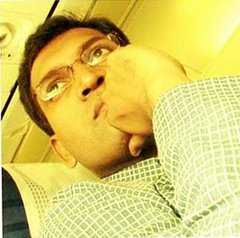

I always wanted to write on Nizams of Hyderabad. The inside story. Not the ones - told and heard many a times. In next following days – I will write stories on the last Nizam – Mukarram Jah which many didn't know. The first part is an introduction and start up to my series.
I always wondered by the last Nizam of Hyderabad, Mukarram Jah abandoned the opulence and intrigues of his Hyderabad palace to drive bulldozers on a dusty sheep station in the Western Australian outback.
Mukarram was an offspring of the union of the two greatest Muslim dynasties of their time. Through his Indian grandmother, he was a descendant of Prophet Mohammed; through his Turkish mother, a descendant of the last Caliph of Turkey.
The first Nizam Mir Qamar Ud Udin Khan was a preacher who wanted to serve under Shahjahan. However, by the time he came back from Haj – Aurangzeb took over the rule and sent him to represent Mughals and fight against the Qutub Sahi rulers.
The Asif Jahi dynasty had been founded in bloodshed and intrigue in the 17th century under the Mughal emperors and in 1724 became an independent state. Since then the city and the state of Hyderabad had been synonymous with culture, opulence and intrigue.
At 35, Mukarram inherited the title from his grandfather, after he disinherited his son for being a "moral pervert" with "sadistic" tastes. Azam Jah.
By the time, Mukarram was made the Nizam – India was independent and princely rule was over. But Osman Ali Khan had a deal with the Government of India to recognise his grandson as the last official Nizam.
Nizam's official title, as it was proclaimed by the president of India in 1967, was "His Exalted Highness, the Rustam of the Age, the Aristotle of the Times, Wal Mamuluk, Asaf Jah VIII, the Conqueror of Dominions, the Regulator of the Realm, Nawab Mir Barakat Ali Khan Bahadur, the Victor in Battles, the Leader of Armies, the Nizam of Hyderabad and Berar." It may have been meaningless, as the princely states had ceased to exist, but the Maharajahs were allowed to retain their titles until 1971.
I was told by close associates of Mukarram and those who knew the Nizam closely that was more of a foreigner in Hyderabad as most of his time was spent aboard including his studies.
At the urging of his beautiful, cultivated mother, and against his grandfather's wishes, Mukarram was sent to Doon School, then to Harrow, Cambridge and Sandhurst in England. His mother despaired of his obsession with machinery.
Mukarram Jah, the new Nizam, brought in his own guards to safeguard his inheritance, but the looting began almost immediately and continued for decades. On April 6, 1967, a Mughal-style durbar was held to install him. At the end of the ceremony, the Olds-mobile that was to carry the royal couple broke down. Amid the solemn ritual, the exotic splendour and a crowd of tens of thousands all Mukarram could think of was how he would fix the imported V8.
Five years later, the seventh Nizam's teeming beneficiaries were still contesting the 54 trusts he left behind. In 1971, Indira Gandhi had stripped the 279 remaining princes of their privy purses and titles. Overwhelmed by his lot, Mukarram flew to Western Australia and bought Murchison House Station, 160km from Geraldton and Havelock House (a Federation mansion) in Perth.
A 2,00,000-hectare outback station in Western Australia was purchased in 1972. He immediately fell in love with his purchase, with its openness and space as it was as far removed from the incestuous atmosphere of Hyderabad, where his own father was taking him to court. "Abu Bakar (the first Caliph of Turkey who was his ancestor) was a shepherd, so I see no reason why I shouldn't be one," he once told a reporter. He would wear an Akubra hat, dusty blue boiler suit and R.M. Williams work boots. His Turkish wife, Esra, appalled by the informality and isolation, returned to London in nine days. The locals treated and greeted him not with deep bows and salutations of "Your Exalted Highness" but with How yer doin', Mukarram or Jah? Some even called him Charlie. Mukarram claimed to have personally graded 300km of roads and fence lines at Murchison House Station.
While he lived in Australia, the plunder of his properties and possessions in India was reaching epidemic proportions. Most of the valuables he left behind in India were sold off by the mid-1970s by his managers, cronies and family members. Projects on his Australian property were abandoned midstream, managers were regularly replaced. Mukarram would drive across Australia and then charter a Lear jet to get home. Murchison was strewn with abandoned graders, tractors and cars. On April 1, 1996, a liquidator was appointed for the property. Mukarram felt cursed and left Murchison that year to flee to his mother's homeland and a modest two-bedroom flat on the coast of Turkey.
His second marriage ended in tragedy. His Australian wife developed a relationship with a bisexual, divorced Mukarram and then died of AIDS in 1989. His younger son from this relationship died of a drug overdose in 2004. Mukarram got married 5 times and has now separated from his current Turkish wife.
In 1967, Mukarram inherited the largest fortune in the world but now lives a life of simplicity and anonymity in Turkey.
NEXT: Exclusive Interview of Mukarram given to Australian newspaper days after he landed in Australia. An insight on why Australia. And also an answer to my question why he left opulence and intrigues of his Hyderabad palace to drive bulldozers on a dusty sheep station in the Western Australian outback.
September 26, 2011
The Last Nizam – Part 1
Posted by
Dinesh Akula
7
comments
![]()
Subscribe to:
Comments (Atom)

